On April 30, 1945, Adolf Hitler and his new bride Eva Braun swallowed cyanide capsules in his Berlin bunker. Then, the Nazi dictator shot himself to ensure his death.
Adolf Hitler’s death brought an abrupt end to one of the darkest eras in human history. On April 30, 1945, the Führer took his own life in his Berlin bunker as the Soviets closed in — ending the reign of the Nazis.
Before his death, Hitler had seen himself as the savior of Germany. Following the country’s humiliating defeat in World War I, Hitler had promised to return Germany to a position of strength. The Great Depression, which hit Germany particularly hard, provided fertile soil for Hitler’s rise.

Corbis/Getty ImagesAdolf Hitler’s death remains one of the most heavily examined moments in history. Here, Adolf Hitler is saluted by Nazi Party members after a 1935 speech.
While writing Mein Kampf in 1924, Hitler claimed that Germany’s problems could be pinned on two enemy groups: countries like France who exacted punitive measures after World War I and Jewish people, who “polluted” the purity of the so-called “master race” of white Aryans.
Hitler rode a wave of domestic discontent to power and became Chancellor of Germany in 1933. Then, he quickly established himself as a dictator. His Nazi Party banned other political parties and suppressed all opposition.
Wielding power, Hitler invaded Poland on September 1, 1939, triggering the outbreak of World War II in Europe. Over the next several years, he would invade other European countries, execute political rivals at home, persecute Germany’s Jews, and plot the formation of horrific concentration camps.
But by April 1945, the tides had turned. Germany was mere weeks away from defeat. And Adolf Hitler’s death was just around the corner.
The Days Leading Up To Adolf Hitler’s Death
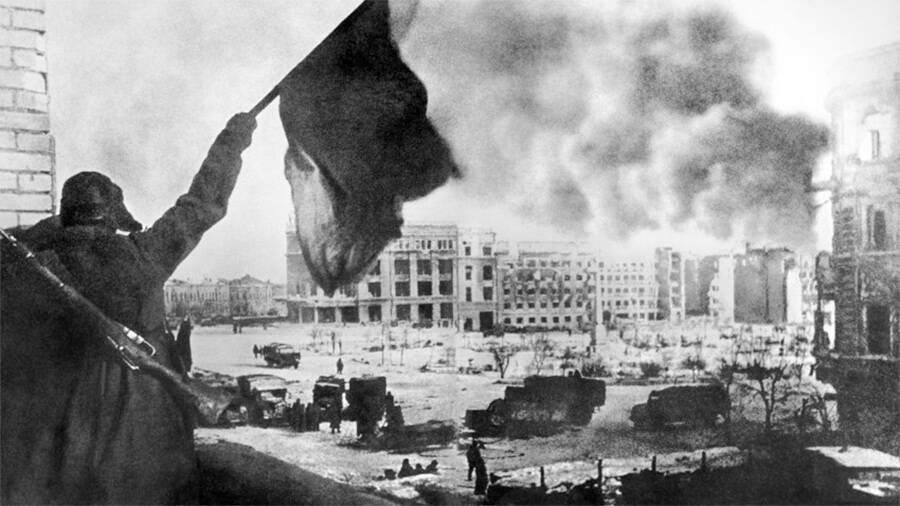
Public DomainThe Soviet victory in the Battle of Stalingrad was a turning point for the Red Army. Germany would remain on the defensive until its defeat in 1945.
In 1945, Germany was on its knees — and few were surprised. The writing had been on the wall for two years, ever since the Soviet Union defeated the Germans at the Battle of Stalingrad in 1943. The next year, Allied forces landed at Normandy and began pushing the Nazis back toward Berlin.
By July 1944, a handful of German military commanders were plotting to assassinate Hitler. By casting aside the dictator, they hoped to negotiate favorable peace terms. But their assassination attempt failed, and Hitler executed 4,000 Germans whom he believed were involved.
As Soviet troops advanced toward Berlin in early 1945, other Allied forces — like the U.S. — were also closing in. Meanwhile, Hitler seemed to vanish. American military forces initially believed that Hitler was hiding away in the Bavarian Alps at his fortress known as the “Eagle’s Nest.”

U.S. ArmyAmerican troops posing at Hitler’s retreat in the Bavarian Alps, known as the “Eagle’s Nest.”
In March 1945, American forces in southern Germany heard reports that as many as 300,000 Nazi loyalists were hiding in the mountains, supplied by an underground weapons factory. Dwight D. Eisenhower, then serving as Supreme Commander of the Allied Forces, feared that they would carry out a guerrilla campaign and drag the war out for years rather than surrender.
In reality, the Nazi propaganda machine was working overtime to hide the true whereabouts of Hitler as the war effort in Germany fell apart. Minister of Propaganda Joseph Goebbels took to the radio to declare that Hitler’s “Werewolves” would defend the dictator to the death: “We Werewolves consider it our supreme duty to kill, to kill, and to kill.”
Meanwhile, Hitler had never left Berlin — he’d been hiding in his bunker for most of 1945. When Allied forces captured Wehrmacht officer Kurt Dittmar, he revealed that the Führer was still in Berlin. Eerily, he also predicted how Hitler would die: “Hitler will either be killed there or commit suicide.”
In the coming days, Dittmar’s conjecture would prove to be true.
The Invasion Of Berlin And Hitler’s Move Underground
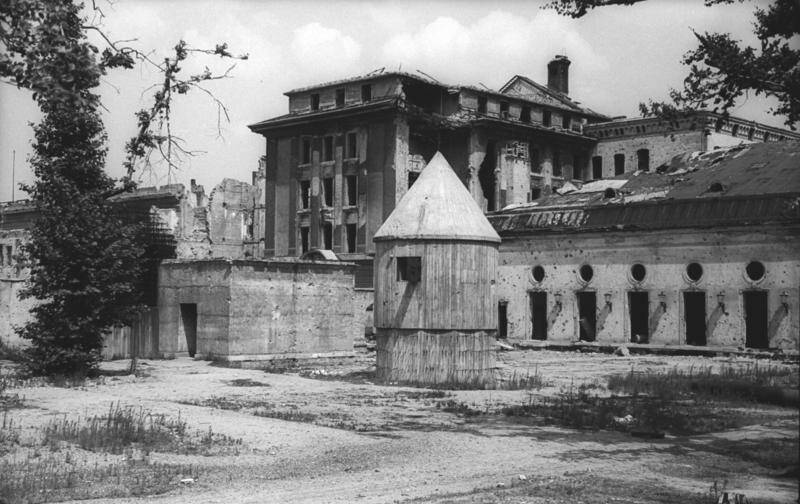
German Federal ArchivesThe Führerbunker in Berlin, just before Soviets destroyed it in 1947.
With the Red Army storming in from the east and other Allied forces moving in from the west, Hitler realized he would lose the war.
On January 16, 1945, Hitler retreated to his underground bunker, which stood more than 50 feet below the Chancellery in Berlin. Known as the Führerbunker, the 2,700-square-foot shelter had a well to provide fresh water and generators to supply electricity.
From this hideaway, surrounded by luxurious furniture and expensive paintings, Hitler directed the war from underground.
The reinforced concrete bunker withstood Allied bombing raids and protected Hitler and other important Nazi leaders like Joseph Goebbels.
But it didn’t protect Hitler from other issues — like poor health and early aging. After years of warfare, Hitler’s hair had turned gray. A tremor appeared on his left side, and his eyesight had grown poor. Just 55, Hitler appeared much older. However, his appearance was soon the least of his concerns.
By April 1945, the Wehrmacht had collapsed. The Red Army reached Berlin with a force of 2.5 million soldiers — who were hungry to hunt down the man who was responsible for so much suffering.
The end had finally come.
Hitler’s Final Days In The Führerbunker
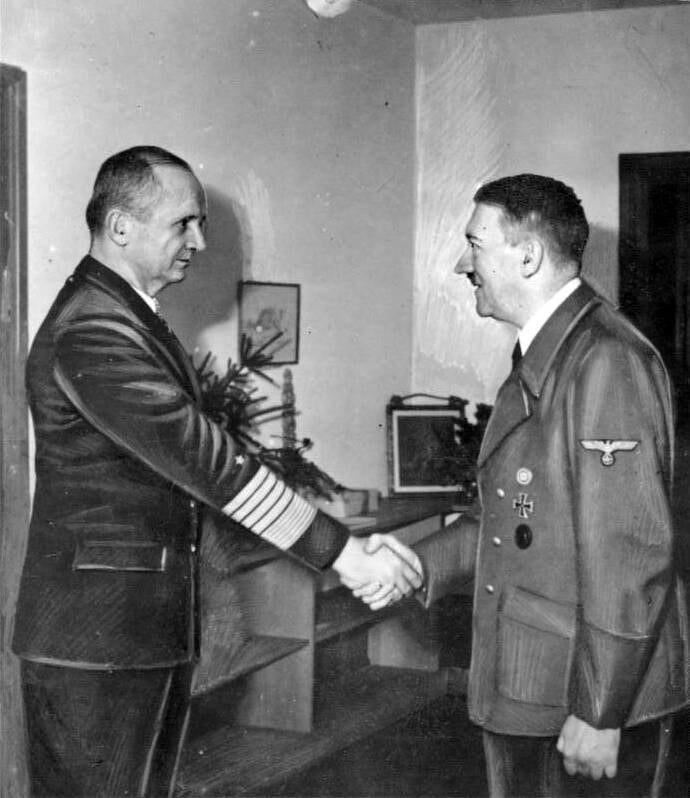
German Federal ArchivesAdolf Hitler meets with Admiral Karl Dönitz in the Führerbunker. Dönitz would briefly become the head of state of Germany after Hitler’s death.
Adolf Hitler dismissed the idea of trying to escape as Soviet troops entered Berlin. He feared capture more than death, especially since he had heard a rumor that the Soviets wanted to lock him in a cage and parade him through Berlin. The humiliation was more than Hitler could bear.
But the Soviets were getting closer. As the end of April drew near, the Red Army was within 300 yards of the Führerbunker.
Still, Hitler fought on. He ordered German troops to fight to the death, issuing orders from the Führerbunker that promised a death sentence for any military commanders who retreated from the Soviet advance.
But behind the scenes, Hitler recognized the hopelessness of the situation. On April 22, Hitler called two of his secretaries, Christa Schroeder and Johanna Wolf, into his office. “He received us in his room looking tired, pale, and listless,” Schroeder reported.
Hitler told his secretaries, “Over the last four days the situation has changed to such an extent that I find myself forced to disperse my staff. As you are the longest-serving, you will go first. In an hour a car leaves for Munich.”
Privately, the Führer began to put his affairs in order. But just before Hitler’s death, he decided to marry his longtime mistress Eva Braun.
How Hitler Married Eva Braun Just Before He Died
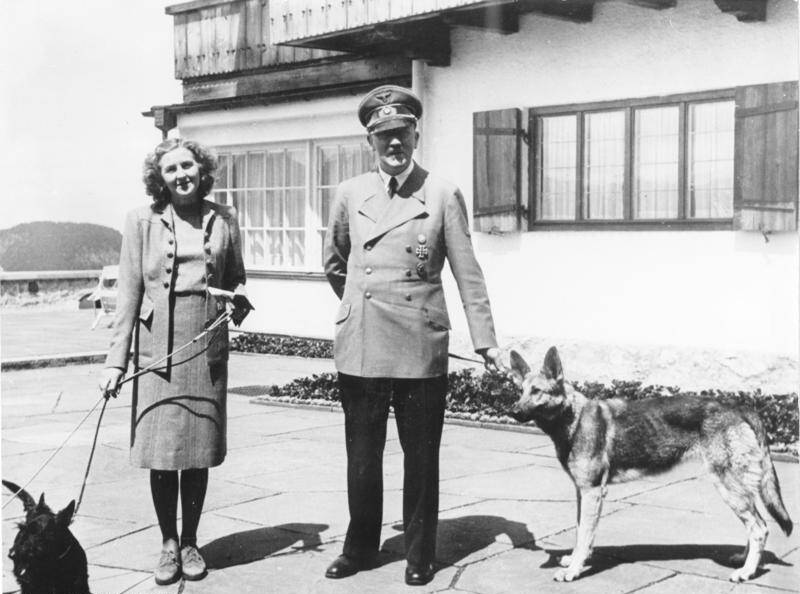
Deutsches BundesarchivEva Braun and Adolf Hitler at Berghof with Hitler’s dog Blondi, who he killed in 1945.
One day before Adolf Hitler died, the Führer figured it was time to get married. On April 29, 1945, he wed Eva Braun, his mistress of 16 years.
Braun and Hitler had first met in 1929 when 17-year-old Braun was working in a Munich photography studio. Braun described the leader of the Nazi Party as “a gentleman of a certain age with a funny mustache.”
Throughout their 16 years together, Hitler hid his relationship with Braun from the outside world. But she was still devoted to him. When Hitler survived an assassination attempt in 1944, Braun vowed, “From our first meeting I swore to follow you anywhere – even unto death – I live only for your love.”
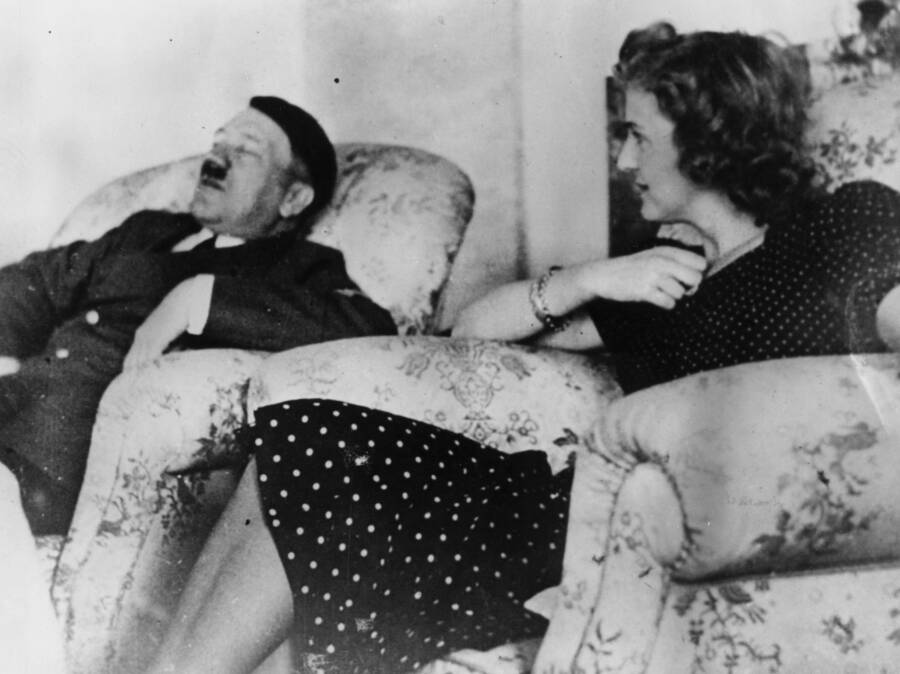
Keystone/Getty ImagesEva Braun watches over Adolf Hitler while he naps.
Braun joined Hitler in his bunker in April 1945. With the Red Army steps away, the two exchanged wedding vows underground.
Before their wedding, Hitler had initially ordered Braun to leave. But she refused and promised fidelity to him until the end. This wasn’t surprising, especially since Braun had once told her friends, “Better that ten thousand others die than he be lost to Germany.”
Braun would follow Hitler anywhere — even into death.
How Did Hitler Die? Inside His Decision To Kill Himself
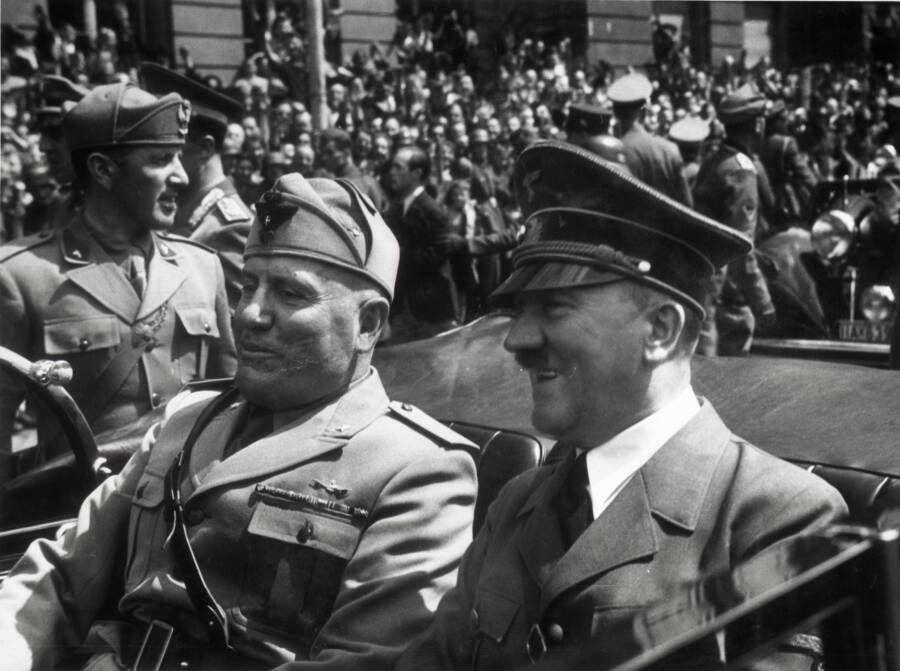
National ArchivesAdolf Hitler and Italian dictator Benito Mussolini in June 1940.
With Braun by his side, Adolf Hitler learned about Benito Mussolini’s execution — and how his corpse was defiled by angry citizens. Vowing to avoid the same fate, the Nazi dictator was determined to die on his own terms: he would die by suicide and his remains would be burned.
On April 29, Hitler began preparing for his death. He ordered his bodyguards to destroy his personal papers. He also told a doctor to test a cyanide capsule out on his “beloved” dog Blondi to make sure it worked.
Not only would killing her confirm the pill’s efficacy for Hitler’s suicide, but it would also ensure that Blondi would not fall into the hands of the Soviets after Hitler was gone. Still, after the dog died, Hitler was “inconsolable.”
The next morning, April 30, a staff member overheard Braun crying, “I would rather die here. I do not want to escape.” By that point, escape would’ve been nearly impossible anyway — the Red Army was nearly on top of the Führerbunker. Hitler ate his final meal – pasta with tomato sauce – as Goebbels tried to convince the Führer not to kill himself.
“Doctor, you know my decision,” Hitler said to Goebbels. “There is no change! You can of course leave Berlin with your family.” Goebbels would not — and neither would his family. Not long after Hitler’s suicide, Goebbels and his wife would kill themselves — and their own children as well.
Hitler assembled his personal staff and shook everyone’s hand. Braun also said her goodbyes. To one of Hitler’s secretaries, Braun said, “Please do try to get out. You may yet make your way through. And give Bavaria my love.”
The Death Of Adolf Hitler And Eva Braun
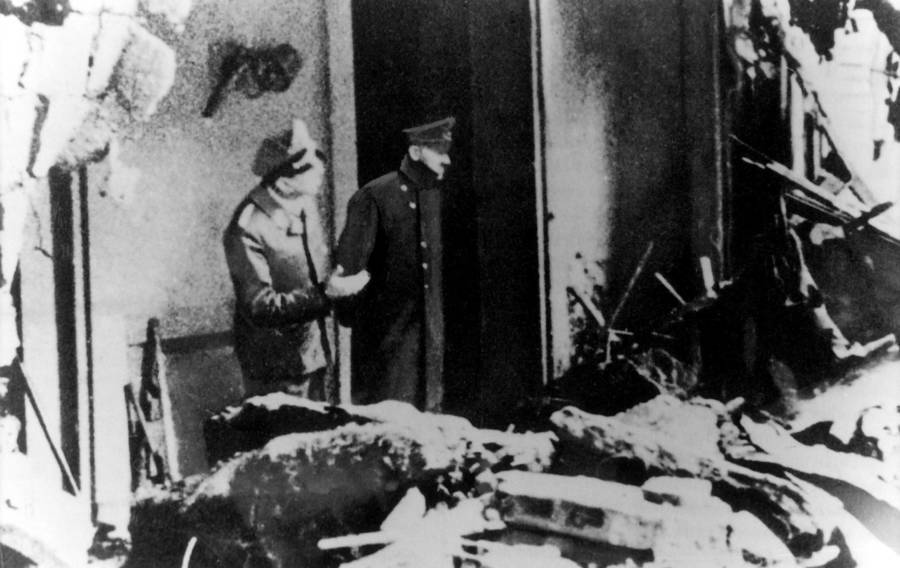
ullsetein bild/Getty ImagesAdolf Hitler surveys the ruins of Berlin in late April 1945, shortly before he killed himself.
While misinformation would later be spread about how Hitler died, he made no secret of his plans to end his own life. And according to witnesses, Hitler was also very specific about how he was going to kill himself.
In a calm voice, Hitler told his valet, SS officer Heinz Linge, “I am going to shoot myself now. You know what you have to do.”
Hitler then gave a Nazi salute and announced, “It is finished, goodbye.”
Deep inside the bunker, Hitler and Braun locked themselves in a private room on the afternoon of April 30, 1945. Eva took a cyanide capsule and waited for it to kill her. Hitler also swallowed a cyanide pill — then shot himself with a pistol.
Outside the room, Hitler’s loyalists waited for the gunshot.
“Suddenly… there is the sound of a shot, so loud, so close, that we all fall silent,” said Hitler’s secretary Traudl Junge. “It echoes on through all the rooms.”
When Junge entered the room with Linge, she said, “I saw Hitler slumped by the table. I didn’t see any blood on his head. And I saw Eva with her knees drawn up lying next to him on the sofa — wearing a white and blue blouse, with a little collar: just a little thing.”
Shortly after Adolf Hitler’s death, his Führerbunker loyalists carried their bodies to a small garden just outside the bunker. The sounds of battle surrounded them, including the sharp retort of Soviet small arms fire.
As Hitler had ordered, his body would be burned — and Braun’s would be burned as well. Goebbels and Bormann doused the bodies in petrol. Alongside the bunker guards, they lit the pyre and quickly withdrew to safety.
Hitler’s inner circle wanted to completely destroy his body. Even though there was no chance that Hitler’s enemies would kill him now, his loyalists didn’t want Hitler’s death — or his remains — to be used for propaganda purposes. But despite their efforts to burn the entire corpse, a small portion of Hitler’s jaw — with a few disease-ridden teeth — remained.
Documents would eventually reveal that Soviet troops indeed recovered Hitler’s remains. But — in the final days of war and for decades after — rumors swirled that Hitler still lived.
Why Rumors Endured That Hitler Survived The War

U.S. Army/Wikimedia CommonsA newspaper declared Hitler dead on May 2, 1945. But many details about how Hitler died remained under wraps.
On May 1, 1945, Karl Dönitz, a German admiral who briefly served as the country’s head of state, prepared to address the German people on the radio and tell them about Adolf Hitler’s death.
But Dönitz was hesitant to tell the truth about how Hitler died. So instead of admitting that Hitler killed himself, Dönitz claimed that the Führer had died in battle, fighting “at the head of his troops.”
Without a body and with little official word regarding Hitler’s death, conspiracy theories quickly began to spread. Some claimed that Hitler had escaped and was living in a cave in the Italian Alps. Others reported seeing the dictator at a French casino.
The Soviets added to the confusion by publicly stating in June 1945 that they had not found Hitler’s remains – suggesting to many that he still lived. And before long, many of the top brass of the Allied powers were suggesting that the Nazi dictator was still alive and had escaped to South America.
From secrecy to disinformation, many people in power laid a fertile ground for disbelief in the official story — which still lingers to this day.
At one point, U.S. officials even tried to hunt down Hitler in Argentina, where he was once rumored to be living in an underground hideout. FBI Director J. Edgar Hoover personally investigated the report, finally concluding that “no serious indication has been received that Adolf Hitler is in Argentina.”
In 2018, French scientists were finally able to prove that Hitler’s death took place in 1945. By analyzing remains of the dictator’s teeth — preserved by the Soviets — the scientists conclusively identified the remains as authentic.
Though more than seven decades have passed since Hitler’s demise, it remains one of the most heavily examined — and controversial — deaths of all time.
The details are ever more haunting when considering Hitler’s horrific legacy. As one historian wrote, “Never in history has such ruination — physical and moral — been associated with the name of one man.”
After learning about Adolf Hitler’s death, read about the Hitler descendants who vow to end his bloodline. Then, take a look at some of the wildest conspiracy theories about Hitler’s death.





